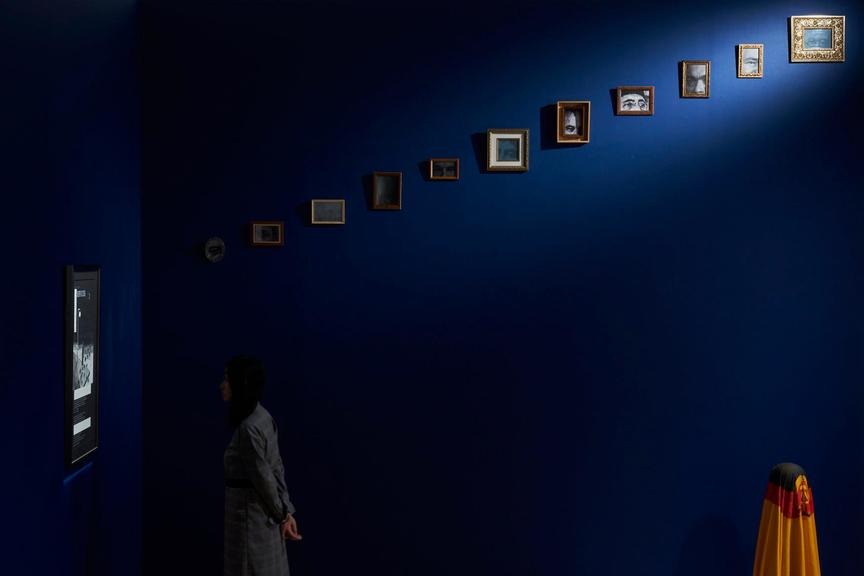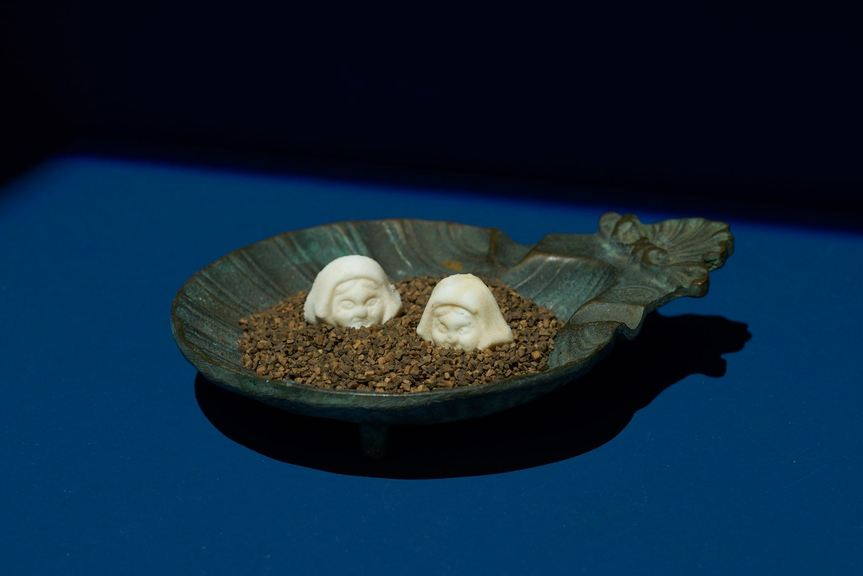-
From Current Issue
-
- Editor’s Letter Fire in the Heart
- Reviews I Gusti Ayu Kadek Murniasih
- Reviews 11th Seoul Mediacity Biennale: “One Escape at a Time”
- Dispatch Networked China
- One on One Monira Al Qadiri on Yukio Mishima
- Essays The rise of independent art spaces in pandemic-era Shanghai
- Features Tuan Andrew Nguyen
- Table of Contents
- Web Exclusives
- Archive
- Subscribe

R
E
V N
E
X
T
Installation view of HO SIN TUNG’s solo exhibition “Swampland,” at Hanart TZ Gallery, Hong Kong, 2020. All photos by South Ho Siu Nam. All images courtesy the artist and Hanart TZ Gallery.
Ho Sin Tung’s “Swampland” at Hanart TZ Gallery was an emotional habitat for bizarre creatures and specters born and mutated out of history and fiction, drawing in viewers and holding them captive in the artist’s universe. The works are allusions to a range of texts from music, literature, and films, as well as remains of personal and national narratives.
On the back wall of the gallery were two pencil, ink, and gouache works on paper (both 2019) inspired by and named after Sufjan Stevens’s songs: Mystery of Love, depicting a landscape of ruins, scattered with broken sculptural fragments of Hamadan Stone Lion, rumored to be built by Alexander the Great in the memory of his general Hephaestion; and Death with Dignity, showing a naked, ghostly woman trespassing the body of a standing man. While the melody and the lyrics evoke feelings of melancholy and loss, these gray scale works embody a sense of desolation and emptiness. The musical sheets under the illustrations, silent and still on paper, document acts of mourning for either the death of Stevens’s mother or of Hephaestion, whose passing brought an end to his alleged romance with Alexander. Enticed by these tracks, Ho’s translation of the music reflects not only her indulgence in the pieces, but also her process of encrypting these intangible emotions.
Installation view of HO SIN TUNG’s (left) Death with Dignity, 2019, pencil, ink and gouache on paper, 74.6 × 105 cm; (middle) Dead Skin, 2019, mixed media, a set of nine, approx. 90 cm each; (right) Mystery of Love, 2019, pencil, ink and gouache on paper, 100.3 × 134.6 cm.
In the center of the room, two carpets with geometrical patterns spread out on the ground, titled 1001 Nights After and 1001 Nights Before (both 2019). Ho replicated the carpets after the props used in Pier Paolo Pasolini’s films, including Salò (1975), set during the Republic of Salò. In the provocative movie, more than a dozen teenagers were subjected to torture for the enjoyment of their captors, and forced to perform sexual acts on these carpets. Piercing eyes of four of these fictional dictators from the film, along with seven others of real political leaders, were staring out of vintage frames arranged in an ascending manner on the adjacent gallery wall. Starting with the worried eyes of Chris Patten, the last governor of British Hong Kong, the lineup also included the Soviet Union’s Mikhail Gorbachev, with his recognizable birthmark, and Egon Krenz of East Germany, whose stare gave me chills. The title of this series, Over (2019), not only implies the subjects’ powerful positions above ordinary citizens, but also highlights the end of their individual reigns and that of their political states. While Ho’s meticulously detailed carpets reflect the brutalities of fascism, the portraits of the fictional characters and historical figures, blurring the line between fantasy and reality, spoke of their faded authoritative powers.
Across the gallery space, visitors stumbled upon a series of colorful “bedsheet ghosts” which corresponded with the eerie gazes of the politicians. Each about 90 centimeters tall, with eyeholes punched in the cloth, these ghosts in Dead Skin (2019) resemble children dressed up for Halloween—only that they are made of flags of countries or regions that no longer exist, including those ruled by the dictators looking downward from Over. Some of these sculptures were placed among the paintings on the walls of the gallery, whereas another stood in the passage between two rooms, obstructing the way. While these symbols of past national entities silently affirm their existence, their problematic legacies often remain unresolved, haunting the present.
Other installation works showcased relics of Ho’s personal life. Same Old Sweet (2019) was presented on five plinths in the corner, displaying a set of differently shaped glass jars containing memorabilia from her past, including decomposing maple candies held in a human skull shaped glass. The jars, deteriorated evidences of failed relationships, were disturbing with their rotting contents and the accompanying intolerable smell, alluding to build-ups of unexpressed emotions that have long expired and can no longer be addressed. This series was Ho’s recent attempt to employ alternative materials, which according to her, is “a witch’s brew with different odd ingredients simmering an unpredictable potion.” Through rumbling books, films, and rotten candies at the bottom of her “Swampland,” Ho demonstrated how past stories can transform and live on, continuing to loom in the shadows of our memories.
Pamela Wong is ArtAsiaPacific’s assistant editor.
Ho Sin Tung’s “Swampland” is on view at Hanart TZ Gallery, Hong Kong, until February 29, 2020.
To read more of ArtAsiaPacific’s articles, visit our Digital Library.



















